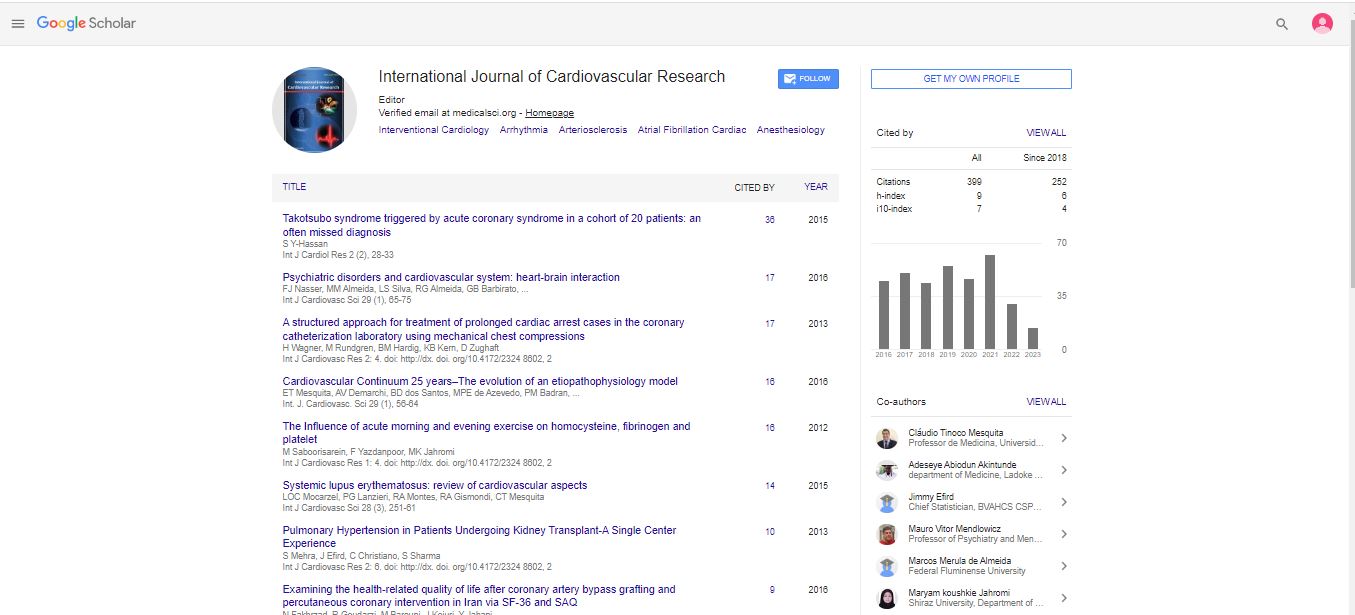Opinion Article, Int J Cardiol Res Vol: 13 Issue: 1
Cardiac Enzymes in Cardiovascular Diagnosis and Prognosis
Han Jun Choi*
1Department of Anesthesiology and Pain Medicine, Sungkyunkwan University School of Medicine, Seoul, Republic of Korea
*Corresponding Author: Han Jun Choi,
Department of Anesthesiology and Pain
Medicine, Sungkyunkwan University School of Medicine, Seoul, Republic of Korea
E-mail: choihan@skku.edu
Received date: 29 January, 2024, Manuscript No. ICRJ-24-134270;
Editor assigned date: 31 January, 2024, PreQC No. ICRJ-24-134270 (PQ);
Reviewed date: 14 February, 2024, QC No. ICRJ-24-134270;
Revised date: 21February, 2024, Manuscript No. ICRJ-24-134270 (R);
Published date: 28 February, 2024, DOI: 10.4172/2324-8602.1000548.
Citation: Choi HJ (2024) Cardiac Enzymes in Cardiovascular Diagnosis and Prognosis. Int J Cardiol Res 13:1.
Description
Cardiac enzymes serve as invaluable biomarkers in the diagnosis, risk stratification, and prognostication of various cardiovascular conditions. These enzymes, released into the bloodstream following myocardial injury, provide crucial insights into the extent and timing of cardiac damage. Cardiac enzymes encompass a spectrum of proteins predominantly localized within myocardial cells. Upon myocardial injury, whether due to ischemia, inflammation, or other pathological processes, these enzymes are liberated into the circulation. Notable cardiac enzymes include Creatine Kinase (CK), CK-MB isoenzyme, cardiac Troponins (cTnI and cTnT), myoglobin, and Lactate Dehydrogenase (LDH). Each enzyme exhibits distinct kinetics, tissue specificity, and diagnostic properties, contributing to their complementary roles in clinical practice.
Diagnostic utility and interpretation
Elevations in cardiac enzymes serve as cardinal markers of myocardial injury, aiding in the diagnosis and risk stratification of Acute Coronary Syndromes (ACS), Myocardial Infarction (MI), myocarditis, and other cardiac pathologies. Troponins, particularly cTnI and cTnT, represent the gold standard biomarkers for myocardial injury detection, owing to their high myocardial specificity and prolonged release kinetics. Elevations in troponin levels above the 99th percentile of a healthy reference population, in conjunction with clinical symptoms and electrocardiographic changes, establish the diagnosis of MI. CK-MB, although less specific than troponins, remains a valuable adjunctive marker, especially in the early hours post-MI, given its rapid release and decline. Myoglobin, a lowmolecular- weight protein, exhibits rapid release following myocardial injury, making it useful for early detection of ischemia, albeit with lower specificity compared to troponins. LDH, although less commonly utilized in contemporary practice, may provide additional diagnostic information in certain clinical scenarios, such as reinfarction or late presentation of MI.
Clinical implications
The measurement and interpretation of cardiac enzymes hold profound clinical implications in guiding therapeutic interventions, risk stratification, and prognostication. Early detection of myocardial injury enables timely initiation of reperfusion strategies, such as Percutaneous Coronary Intervention (PCI) or thrombolytic therapy, thereby salvaging viable myocardium and improving patient outcomes. Serial monitoring of cardiac enzymes facilitates the assessment of infarct size, myocardial salvage, and the efficacy of reperfusion therapies, guiding subsequent management decisions. Furthermore, elevated cardiac enzyme levels portend a higher risk of adverse cardiovascular events, including recurrent ischemia, heart failure, arrhythmias, and mortality. Thus, cardiac enzymes serve as valuable prognostic markers, aiding in risk stratification and long-term management planning. Integration of cardiac enzyme data with clinical parameters and imaging modalities enhances risk prediction models and facilitates personalized patient care.
Conclusion
In conclusion, cardiac enzymes play a pivotal role in the diagnosis, risk stratification, and prognostication of various cardiovascular conditions. Their measurement and interpretation provide crucial insights into myocardial injury, guiding therapeutic interventions and informing prognosis. By leveraging the diagnostic utility of cardiac enzymes, healthcare professionals can optimize patient care, mitigate adverse outcomes, and improve cardiovascular outcomes. Continued study and efforts aimed at refining cardiac biomarker assays and elucidating their pathophysiological roles hold promise for advancing the field of cardiovascular medicine.
 Spanish
Spanish  Chinese
Chinese  Russian
Russian  German
German  French
French  Japanese
Japanese  Portuguese
Portuguese  Hindi
Hindi 



